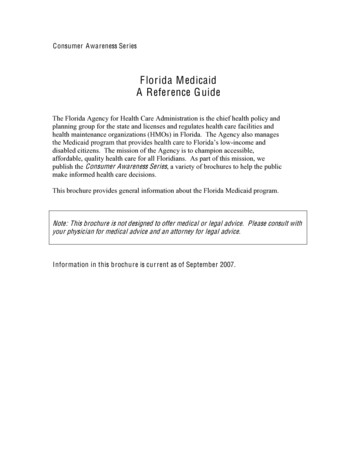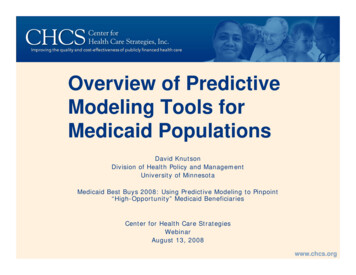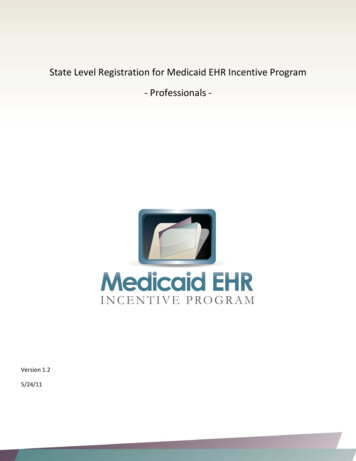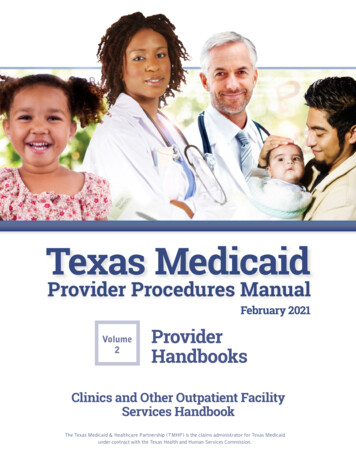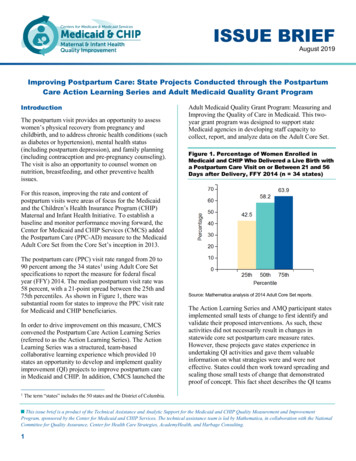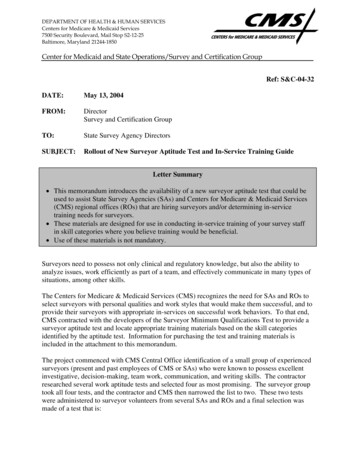
Transcription
DEPARTMENT OF HEALTH & HUMAN SERVICESCenters for Medicare & Medicaid Services7500 Security Boulevard, Mail Stop S2-12-25Baltimore, Maryland 21244-1850Center for Medicaid and State Operations/Survey and Certification GroupRef: S&C-04-32DATE:May 13, 2004FROM:DirectorSurvey and Certification GroupTO:State Survey Agency DirectorsSUBJECT:Rollout of New Surveyor Aptitude Test and In-Service Training GuideLetter Summary This memorandum introduces the availability of a new surveyor aptitude test that could beused to assist State Survey Agencies (SAs) and Centers for Medicare & Medicaid Services(CMS) regional offices (ROs) that are hiring surveyors and/or determining in-servicetraining needs for surveyors. These materials are designed for use in conducting in-service training of your survey staffin skill categories where you believe training would be beneficial. Use of these materials is not mandatory.Surveyors need to possess not only clinical and regulatory knowledge, but also the ability toanalyze issues, work efficiently as part of a team, and effectively communicate in many types ofsituations, among other skills.The Centers for Medicare & Medicaid Services (CMS) recognizes the need for SAs and ROs toselect surveyors with personal qualities and work styles that would make them successful, and toprovide their surveyors with appropriate in-services on successful work behaviors. To that end,CMS contracted with the developers of the Surveyor Minimum Qualifications Test to provide asurveyor aptitude test and locate appropriate training materials based on the skill categoriesidentified by the aptitude test. Information for purchasing the test and training materials isincluded in the attachment to this memorandum.The project commenced with CMS Central Office identification of a small group of experiencedsurveyors (present and past employees of CMS or SAs) who were known to possess excellentinvestigative, decision-making, team work, communication, and writing skills. The contractorresearched several work aptitude tests and selected four as most promising. The surveyor grouptook all four tests, and the contractor and CMS then narrowed the list to two. These two testswere administered to surveyor volunteers from several SAs and ROs and a final selection wasmade of a test that is:
Page 2 – State Survey Agency DirectorsAppropriate to skills needed in the surveyor job;Off the shelf;Low cost;Easy to administer; andSubstantive in the description of results for each test taker.Attached are the executive summary of the research report and the test administration guide. Inaddition to the description of the aptitude testing process and results, the guide lists an extensiveset of training resources that are arranged by skill/trait. You are invited to order and use thesematerials to design and conduct in-service training of your survey staff in skill categories whereyou believe training would be beneficial. Use of these materials is not mandatory.If you have any questions or comments about this resource, please contact Karen Schoeneman at410-786-6855, or via email at kschoeneman@cms.hhs.govT.Effective Date: Immediately.Training: This memorandum should be shared with SA and RO supervisory and training staff./s/Thomas A. HamiltonAttachments
Identifying and Selecting a Screening Test for Long-term CareSurveyorsAn Executive SummaryEffective employee selection and development are among the greatest challenges facingemployers today. Gaps between the skills of candidates and the requirements of jobs arecommonplace and well documented in the popular literature. The employment context isfurther complicated by the fact that successful job performance is not solely a function oftraining and expertise, but of attitude and personality as well. Yet top quality employees arecritical for organizational success.To help state agencies meet the challenges inherent in employee selection and development,the Centers for Medicare and Medicaid Services (CMS) retained Performance-Based Selection,Ltd. (PBS) to review and evaluate the applicability and usefulness of off-the-shelf assessmenttools for selecting Long-term Care Surveyors and for supporting ongoing development andperformance enhancement initiatives.Tests are efficient, cost effective, objective, standardized (providing a common metric tocompare candidates/incumbents), reliable, and predictive of subsequent job performance.For tests to be value-added, however, they must be job-related – they must target and measurethe competencies, skills, abilities, attributes, or characteristics important for successful jobperformance. Identifying and selecting a test is more than a simple matter of looking forrelevant dimensions. The test’s psychometric properties are equally important in determining itsutility and legal defensibility.The first step of the project was to identify what the test should measure – that is, to identify theskills and attributes that contribute to or determine success as a surveyor. To define the skillsand attributes required, we relied on those who know the job best. Specifically, CMS identified10 Long-term Care Surveyors who are recognized and respected for their expertise andexcellence. This elite panel identified the skills and attributes required, which are as follows: Skill in Gathering and Integrating InformationTeamworkProfessional PracticeFlexibilityCommunicationInvestigative SkillsEmotional Understanding, andInformation Processing, Prioritizing, and Compiling.Each skill/attribute was defined through an iterative process and was approved by CMSrepresentatives before being finalized.
The next step was to review published test products for applicability, relevance, ease of use,and impact. The PBS review included 22 different test publishers and 19 different test productsthat linked to the aptitudes and/or project goals in one way or another. Standardized criteriawere used to evaluate the tests and included: Intended uses – Is the assessment tool intended for use in selection, indevelopment, or both?Validity evidence – Is there evidence to support that the assessment measuresthe constructs defined and/or is predictive of important performance outcomes?Qualifications required for test use – Is specialized training (e.g., advanceddegree in psychology) required for test use?Practicality of administration – Are a variety of administration modalities available(online, CD, and/or paper and pencil)?Ease of score interpretation – Are score reports easy to read and to understand?Cost per use – Is the per candidate price both competitive and reasonable?Applicant/candidate acceptance – Will job candidates/incumbents perceive thetest items as relevant to a work context and reasonable to ask?Availability of development references/suggestions – Does the score reportinclude suggestions for activities to help develop skills, abilities, and/oraptitudes?Job relevance – Are the dimensions measured by the assessment representativeof the skills and aptitudes identified as important for Long-term Care Surveyors?Using the criteria listed above, 4 tests were selected for further review and consideration.These tests were administered to the panel of 10 elite surveyors (8 of whom participated) andthe search was narrowed to the most promising two. These two tests were then administered tovolunteer surveyors to further evaluate their utility and potential use. Of particular interest werethe abilities of the tests to differentiate between the elite panel and the volunteers and todevelop a profile of effective surveyor skills and attributes that made sense given the nature ofthe job.Following the general administration, scores and score profiles were compared. The WorkPersonality Index (WPI), published by Psychometrics Canada, Ltd., was found to best meet thegoals and objectives of CMS. The WPI is appropriate for both selection and development, iscost competitive, and is acceptable to both job applicants and incumbents. More importantly, itis clearly related to the job and work context, measuring many of the skills and attributesidentified as important for success. Finally, the WPI, in research completed by the testpublisher, has proven to be reliable and predictive of performance effectiveness.To maximize the utility of the WPI, a customized Administration Guide was prepared tosupplement and compliment the User’s Manual prepared by the test publisher. The customAdministration Guide provides an overview of the project and the test. It includes sample scorereports, suggested score interpretation guidelines, and norm tables. Finally, the AdministrationGuide also includes a whole host of resource materials, organized by score dimension andintended for use by a state administrator or training and development coordinator, that can beused to structure training programs and help incumbent surveyors address developmentalneeds or capitalize on personal strengths.
Centers for Medicare andMedicaid ServicesAdministration Guide:The Use of an Aptitude Testfor Long-term Care Surveyor Selectionand/or DevelopmentSeptember 2003Prepared by:Performance-Based Selection, Ltd.28915 Clemens Road, Suite 216Westlake, OH 44145(440)-808-1514
ContentsIntroduction .1Chapter 1 – Background and Overview.2Prerequisite Skills and Attributes .2The Test Review .2The Test Itself .3Chapter 2 – Administration of the Work Personality Index.5Chapter 3 – WPI Score Interpretation Guidelines.7Chapter 4 – Training and Resource Materials .11Ambition (Motivation to Improve) .11Initiative .12Flexibility .13Energy.15Leadership .16Persistence .17Attention to Detail .17Rule Following.17Dependability.18Teamwork .19Concern for Others.24Outgoing.26Democratic .27Innovation.28Analytical Thinking .29Self Control .30Stress Tolerance .31TablesTable 1 – Work Personality Index (WPI) Dimensions .3Table 2 – Link between Long-term Care Surveyor Skills and Aptitudes and theWork Personality Index .4Table 3 – Sample Score Report .9Table 4 – Work Personality Index: Representative Surveyor Scores.10AppendicesAppendix A: Long-term Care Surveyor: Skills and Aptitudes for Selection and DevelopmentAppendix B: Sample WPI Select ReportAppendix C: Sample WPI Personal Effectiveness Reporti
IntroductionThis Guide details the procedures and protocol for implementation and use of a publishedassessment tool in employee selection and development programs for Long-term CareSurveyors.The assessment tool, the Work Personality Index (WPI), measures personality traits that havebeen proven to influence work performance. The WPI was selected following a review ofpublished tests for its job relevance, candidate acceptance, utility, and validity. Its use isoptional and is intended to supplement existing selection systems and performance appraisal,evaluation, or management programs.This Administrative Guide is structured as follows:1.Background and Overview – includes the rationale and research supporting the use ofthe WPI.2.Administration -- describes general administrative instructions and details where andhow to obtain test materials.3.Score Interpretation Guidelines – describes how to use the scores to enhance employeeselection and to support ongoing surveyor development and performance management.4.Resources – includes resources, for each dimension, to help you in structuring trainingprograms and in guiding individual development based on WPI score reports.1
Chapter 1: Background and OverviewIn spring of 2003, the Centers for Medicare and Medicaid Services (CMS) retainedPerformance-Based Selection, Ltd. (PBS) to review and evaluate the applicability andusefulness of off-the-shelf assessment tools for selecting Long-term Care Surveyors and forsupporting ongoing development and performance enhancement initiatives of incumbents.Prerequisite Skills and AptitudesThe first step of the project was to identify the skills and aptitudes important for andpredictive of successful job performance. Ten (10) experienced Long-term CareSurveyors – representing various disciplines, agencies, and geographic regions andwidely recognized for their expertise and consistency and quality of performance – wereinvited to serve on a panel to review job requirements and define performanceexpectations. Through an iterative process, the panel identified the following skills andaptitudes as critical for success: Skill in a Gathering and Integrating InformationTeamworkProfessional PracticeFlexibilityCommunication SkillsInvestigative SkillsEmotional UnderstandingInformation ProcessingDefinitions are given in Appendix A.The Test ReviewThe skills and attributes were used to structure and guide the review of published testproducts. A total of 19 different published assessment tools were identified as relevantand were considered. The criteria used for evaluation included: Intended uses – Is the assessment tool intended for use in selection, indevelopment, or both?Validity evidence – Is there evidence to support that the assessment measuresthe constructs defined and/or is predictive of important performance outcomes?Qualifications required for test use – Is specialized training (e.g., advanceddegree in psychology) required for test use?Practicality of administration – Are a variety of administration modalities available(online, CD, and/or paper and pencil)?Ease of score interpretation – Are score reports easy to read and to understand?Cost per use – Is the per candidate price both competitive and reasonable?Applicant/candidate acceptance – Will job candidates/incumbents perceive thetest items as relevant to a work context and reasonable to ask?Availability of development references/suggestions – Does the score reportinclude suggestions for activities to help develop skills, abilities, and/oraptitudes?Job relevance – Are the dimensions measured by the assessment representativeof the skills and aptitudes identified as important in selection of Long-term CareSurveyors?2
Through a review and consideration of the criteria listed above and in conjunction withCMS representatives, four assessment tools were selected for trial use. Each of the fourtests was administered to the panel of 10 experienced and expert Long-term CareSurveyors. In addition to completing the assessment, the surveyors were asked to rateeach instrument. By comparing the score distributions, the ratings obtained, and thescore reports, two tests were selected for a second and broader-based trialadministration.The two remaining assessments were administered to volunteers from the BasicSurveyor Training Program and to surveyors from the District of Columbia and the statesof Alabama and Washington. A total of 58 surveyors participated. Score distributionswere compared to determine which assessment would provide the most usefulinformation.The Test ItselfThe Work Personality Index (WPI) was the assessment tool that best met all criteria, andis the subject and focus of this administration guide. The WPI is useful for selection,individual development, and team building. Specifically, it can be used to streamline theselection process, guide preemployment interviews, identify personal strengths anddevelopmental needs, and define differences in team members’ preferences and workstyles.The WPI is a self-report personality inventory that measures 17 different dimensions thatinfluence work performance and task effectiveness including how people work withothers, solve problems, manage change, and deal with stress. The 17 dimensions areorganized into five global constructs and are listed in Table 1. The link between the WPIdimensions and the skills and aptitudes important for Long-term Care Surveyors isillustrated in Table 2.Table 1WPI DimensionsAchievement OrientationAmbition (Motivation to ientiousnessPersistenceAttention to DetailRule FollowingDependabilitySocial OrientationTeamworkConcern for OthersOutgoingDemocraticPractical IntelligenceInnovativeAnalytical ThinkingAdjustmentSelf ControlStress Tolerance3
Table 2Link between Long-term Care Surveyor Skills and Aptitudes and the Work Personality derstandingAmbition (Motivation sistenceAttention to DetailRule FollowingDependabilityTeamworkConcern for OthersOutgoingDemocraticInnovationAnalytical ThinkingSelf ControlStress ToleranceTeamworkWPIDimensionsSkill in Gathering& IntegratingInformationSkills and XXXXXXXXXXXXXXX LinkXX Strong Link4XXXX
Chapter 2 – Administration of the Work Personality IndexThe WPI can be administered online or in paper and pencil format, and will support employeeselection and/or development. To use the WPI:1.Determine the reason and rationale for test use. The method of administration, thescore reports, and the costs will vary based on your reasons for using the test.Abbreviated reports and/or paper-and-pencil administration may better suit employeeselection needs while online administration and expanded reports may be more feasiblefor developmental purposes.2.Determine if online administration is feasible. Candidates must have access to acomputer and Internet connection to complete the test online.3.Review the intended uses of the different score reports available and select the one thatbest meets your needs.WPI Select Report ( 17.00 per use)* – is designed for employee selection. It includes agraphical score report summary (for each of the 17 dimensions) and a narrativeinterpretation of the scores.WPI Personal Effectiveness Report ( 19.00 per use)* – is designed for personaldevelopment and performance enhancement. It also includes the same graphical scorereport. The narrative, however, focuses on personal strengths and suggestions forimproving personal effectiveness.Note that the WPI Job Match Report ( 25.00 set-up fee and 17.00/use)* may also beof interest. In this report, the similarity of the scores obtained by each candidate iscompared to those identified as desirable/required. You may define the desired profileby rating the importance of each dimension for successful job performance, or you maybase the target profile on the scores obtained by the experienced and expert Long-termCare Surveyors (see Table 4 in Chapter 3).Samples of the two recommended reports (the WPI Select Report and the WPI PersonalEffectiveness Report) are given in Appendices B and C respectively.4.Sign up for/order the WPI. Contact information is given below:Psychometrics Canada, Ltd.7125 77 AvenueEdmonton AB T6B 0B5CanadaTel: 1-800-661-5158Email: info@psychometrics.comWeb: www.psychometrics.com*Note that the prices listed were obtained from the test publisher and were effective in October 2003.5
5.Prepare for test administration and use.The WPI is largely self-administered, and can be completed individually or in groups.There is no time limit, and most people complete the 153 items in approximately 30minutes.When administering the WPI, be sure to: have all required materials on hand.provide a quiet room, relatively free from distractions, and enough space for eachperson to have some privacy while answering items.introduce the assessment and how it will be used. Include the following:1. The WPI is a personality inventory, not a test. There are no right or wronganswers.2. There is no time limit for completing the WPI, but most people complete it in30 minutes.3. When answering the items, it is best not to think too long about any specificitem. Generally, your first response is your best response.4. Encourage candidates to answer all items. If they are uncertain about aresponse, suggest they select N for Neutral.5. Tell people who take the test what will happen with their results – for exampleas a factor in the selection process or as a tool for development.6. Provide an opportunity for candidates to ask questions.7. Emphasize the importance of honesty in responding and of carefully readingeach item.8. Remind candidates, if paper and pencil administration is used, to be sure tomatch the number of the item in the test booklet to the number on the answersheet.Detailed administration instructions are available from the test publisher in the WPIUsers Manual. It is strongly recommended that a Users Manual be obtained andreviewed prior to test administration or use. A copy of the Manual may be purchased for 50.00* from the test publisher or may be downloaded for free from the publisher’swebsite. The Manual includes definitions of each dimension, detailed administrationinstructions, and score interpretation guidelines.*Note that the prices listed were obtained from the test publisher and were effective in October 2003.6
Chapter 3 – WPI Score Interpretation GuidelinesThe report includes a graphic summary of results, organized by the five global personalitycharacteristics and including scores on each of the 17 dimensions. A sample score report isgiven in Table 3. Interpretation guidelines follow:1.Review the validity of WPI results. If more than 10 items have been left unanswered,interpret the results cautiously.2.Review the profile of scores, which will tell you strengths, preferences, tendencies, andchallenges. The scores are given as stens and are represented on a bipolar scale. Asten is a standard scale of measurement that divides scores into ten equal categories.Stens have an average score of 5.5 and a standard deviation of 2. Fifty-percent of thegeneral population will fall above 5.5 and fifty-percent below.An example of how the score will be represented and how it may be interpreted is givenbelow.Flexibility1Values order andpredictability;prefers adaptationto innovation.2.3.45.6.7 8.9.10.Prefers variety andnovelty; adaptsquickly to change;dislikes routine.This candidate scored above average on Flexibility (i.e., above 5.5). High scores are notnecessarily better; high scores and low scores both have meaning and indicate astronger preference for that end of the scale. In the example given above, the score of 7indicates that the candidate is flexible and tends to prefer novelty to routine.It is important to remember that scores are neither good or bad – they are more or lessappropriate given the nature of the job. You may interpret the scale points as follows:1 or 10 Extremely2 or 9 Highly; Definitely3 or 8 Very4 or 7 Tendency to5 or 6 TypicalDetailed score interpretation guidelines are given in the WPI Users Manual – pages 13through 17 (available online, see Chapter 2 for additional details). The guidelinesinclude definitions of each dimension and descriptions of high and low scores.3.Compare scores to benchmarks. The scores obtained by the two surveyor groups aregiven in Table 4. Note that, on average, all surveyors scored 5 or above on all 17scales, indicating that they are at the mid point or high end of the scale. In addition, thetable indicates those dimensions that best reflect important job requirements for Longterm Care Surveyors.7
For selection, review the profile of scores and then note any scores thatsignificantly depart from those typically obtained by surveyors (see Table 4). Usea difference of 1.0 or more as a guide for interpretation. If the dimension is onethat is critical for job performance (e.g., Analytical Thinking), you may want to askinterview questions that target that dimension for follow-up and clarification.Note that the WPI is not intended to stand-alone. The scores obtained should beused to supplement the existing selection process and to guide the structuredinterview. For development, you can use the suggestions provided in the WPI PersonalEffectiveness Report to structure an individualized action plan. In guidingdevelopment, be sure to focus developmental efforts on only two to three areasat a time.We have also compiled training materials that may help in guiding developmentand performance enhancement. Please see Chapter 4 for additional information.4.Compile all available information about the applicant/candidate. Compare WPI scoreswith information that you have obtained through other sources, such as applications,interviews, and/or performance evaluations.5.Make a decision considering all available information. If the WPI is to be used to selectemployees, scores need not be shared with the applicant. If development is the primaryfocus, individual feedback sessions should be held where WPI scores are presented anddiscussed, and an action plan prepared.8
Table 3 - Sample Score Reportachievement orientation78867644775347781234.prefers stable work, untertakes newprojects only after discussion with others.values order and predictability, prefersadaptation to innovation56789 10.sets difficult goals, has high aspirations,competitive and driven to succeed.proactive, quickly takes initiative, enjoysidentifying and solving new challenges.prefers variety and novelty, adapts quicklyto change, dislikes routime.very energetic, works well under pressure,tends to be involved in many activities.assumes leadership positions, dominantand forceful, enjoys influencing othersAmbitioneasy going, non-competitive, focus onachievable, less ambitious targets.Initiative.Flexibility.Energylikes to work at a steady pace, dislikespressure filled work.avoids leadership positions, consultative,happy to let others lead.Conscientiousness123456789 10.enjoys overcoming obstacles, verypersistent, works until task is finished.well organized, methodical, enjoys detailedwork.follows rules and regulations even wheninconvenient, likes specific guidelines.dependable, meets obligations anddeadlinesprefers work that can be completedquickly, dislikes overcoming obstaclesfocuses on global issues, not preoccupiedwith detail, will cut corners to meetdeadlinesnot restricted by rules, prefers generalguidelines to specific regulations.LeadershipPersistence.Attention to Detail.Rule-Following.place less importance on meetingdeadlines, casual about work requirements .Dependability.56789 10.prefers work that involves socialinteraction, likes getting others involvedSocial Orientation1234formal and reserved, does best work whenalone.Teamworkunaware of others feelings, reluctant to getinvolved in peoples problems.Concern for Others.caring and understanding, shows concernfor others, sympathetic.talkative and outgoing, enjoys meetingnew people.makes decisions through consultation,works well with supervisionOutgoingquiet and shy, prefers small groups, rarelyseeks people out.makes decisions independently, seldomlooks for advice.123456789 10.creative and original, likes solvingproblems, intellectually curious.analytical, cautious and deliberate, takeslogical approach to problem solvingPractical Intelligence8Select Report: Sally Sampleprefers using and building uponestablished methods, avoidsunconventional ideas.DemocraticInnovation.spontaneous, makes quick decisi
Survey and Certification Group TO: State Survey Agency Directors SUBJECT: Rollout of New Surveyor Aptitude Test and In-Service Training Guide Letter Summary This memorandum introduces the availability of a new surveyor aptitude test that could be used to assist State Survey Agencies (SAs) and Centers for Medicare & Medicaid Services

